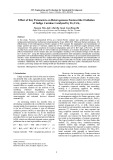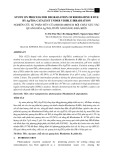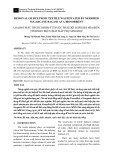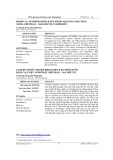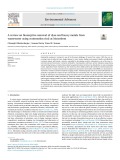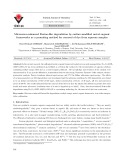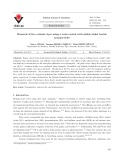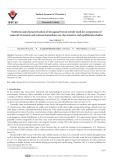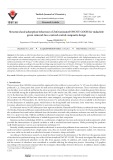
Initial dye concentration
-
In this paper, we discuss the efficiency of using a Fe2V4O13 catalyst in a heterogeneous Fenton-like process for the degradation and mineralization of Ind. We examined various factors that influence the reaction, such as the initial pH of the reaction mixture, the initial concentration of hydrogen peroxide, the amount of the Fe2V4O13 catalyst, and the reaction temperature was investigated.
 9p
9p  vijeff
vijeff
 30-11-2023
30-11-2023
 5
5
 2
2
 Download
Download
-
In the present investigation, to explore the possibility of Ag/TiO2 for photocatalytic degradation of RB dye in visible light has been carried out. The effects of various parameters such as catalyst amount, initial dye concentration, pH have been investigated on the photocatalytic degradation of RB in the presence Ag/TiO2 as a photocatalyst under irradiation of visible light.
 7p
7p  vidoctorstrange
vidoctorstrange
 06-05-2023
06-05-2023
 4
4
 2
2
 Download
Download
-
In this study, the sugarcane bagasse grafted with citric acid was used as a low-cost biosorbent for removal of dyes from the textile wastewater. The adsorption parameters such as initial pH values, dyes concentrations, adsorbent dosages and contact times were investigated by the batch experiments. The Freundlich and Langmuir adsorption isotherm models were used to evaluate the experimental data.
 6p
6p  vidoctorstrange
vidoctorstrange
 06-05-2023
06-05-2023
 6
6
 2
2
 Download
Download
-
Chitosan-magnetite composite (CS-MNPs) was made by an in-situ combined co-precipitation method. Material characteristics were investigated by X-ray, SEM, BET, and VSM methods. CS-MNPs has a spherical shape with a diameter of around 20 nm and a surface area of 119.43 m2 /g.
 8p
8p  viirenerosenfeld
viirenerosenfeld
 02-06-2022
02-06-2022
 11
11
 1
1
 Download
Download
-
This paper reviews the various important aspects of utilization of watermelon rind as a biosorbent for removing dyes and heavy metals from contaminated water. The effects of several factors such as pH, initial solute concentration, biosorbent dose, co-solute concentration, activation etc. has been reviewed in this paper.
 13p
13p  thebadguys
thebadguys
 15-01-2022
15-01-2022
 10
10
 0
0
 Download
Download
-
The main aim of this study was to evaluate the efficacy of montmorillonite clay for the adsorption of C.I. Basic Yellow 2 (BY2) dye from aqueous media. The experimental results were processed by response surface methodology based on a central composite design (CCD). The effect of four main variables, including initial BY2 concentration, adsorbent dosage, reaction time, and temperature on the removal of BY2 was evaluated by the model. The accuracy of the model and regression coefficients was appraised by employing analysis of variance.
 16p
16p  langthannam
langthannam
 29-12-2021
29-12-2021
 9
9
 0
0
 Download
Download
-
Polyacrylamide–montmorillonite (PAAm-Mt) and polyacrylamide–clinoptilolite (PAAm-Z) composites were prepared by cross-linked polymerization of acrylamide in dispersions of Mt and Z. The composites were characterized by FT-IR, SEM, XRD, CEC, and PZC analysis. The adsorptive features of PAAm-Mt and PAAm-Z for methylene blue (MB) were investigated by their relevance to initial dye concentration, temperature, contact time, PZC, and pH.
 16p
16p  langthannam
langthannam
 29-12-2021
29-12-2021
 10
10
 0
0
 Download
Download
-
In the present study, ZnO nanostructures were ultrasonically synthesized and immobilized on the surface of diatomite and used for visible light photocatalysis of Acid Red 88 (AR88) in the aqueous phase. Scanning electron microscopy (SEM) and X-ray diffraction (XRD) analyses were employed for characterization of the samples. The process was optimized via response surface methodology (RSM) on the basis of central composite design (CCD).
 13p
13p  langthannam
langthannam
 29-12-2021
29-12-2021
 8
8
 0
0
 Download
Download
-
The influence of various operational parameters including initial dye concentration, catalyst concentration, pH value, inlet gas concentration, and type of irradiation source was investigated on the efficiency of the photocatalytic ozonation removal of DR54. Various inorganic and organic reactive oxygen species (ROS) scavengers were applied to investigate the mechanism of photocatalytic ozonation. In addition, a three-layer perceptron neural network was developed for modeling the relationship between the operational parameters and decolorization efficiency of the dye.
 19p
19p  langthannam
langthannam
 29-12-2021
29-12-2021
 8
8
 0
0
 Download
Download
-
Tetra–n-butylammonium bromide modified sugar beet pulp (TBAB–SBP) with good biosorption and regeneration potential was prepared for removal of dye from contaminated solutions. The decolorization performance of TBAB–SBP was investigated using Reactive Yellow 2 (RY2) as a model dye. The characterization of the modified biosorbent was investigated by IR, SEM, zeta potential, and BET surface area analysis to discuss the decolorization mechanism. The effects of initial pH, biosorbent amount, contact time, dye concentration, and flow rate on the treatment process were examined.
 11p
11p  langthannam
langthannam
 29-12-2021
29-12-2021
 4
4
 0
0
 Download
Download
-
In this work, the degradation of Basic Red 29 (BR29), an azo dye, was investigated using a high-frequency ultrasonic reactor (300 kHz). The influence of several parameters such as initial substrate concentration (5–200 mg L−1 ), pH (3–10.1), ultrasonic power (20–80 W), and nature of the dissolved gas (Ar, air, and N2) on the degradation of BR29 was assessed. Additionally, the impact of natural matrices (seawater and natural and river waters) on the degradation rate of BR29 was clarified.
 17p
17p  langthannam
langthannam
 29-12-2021
29-12-2021
 7
7
 0
0
 Download
Download
-
In the current research, the sulfonated metal–organic framework loaded on iron oxide nanoparticles, Fe3O4@MIL100(Fe)-OSO3H, has been synthesized and utilized as a Fenton-like catalyst for the decolorization of aqueous solutions containing methyl orange (MO) dye as a model organic pollutant. The morphology and structure of the catalyst were characterized by X-ray powder diffraction, transmission electron microscopy, Brunauer–Emmett–Teller analysis, thermogravimetric analysis, Fourier transform infrared spectroscopy, and UV-Vis diffuse reflectance spectroscopy.
 14p
14p  langthannam
langthannam
 29-12-2021
29-12-2021
 19
19
 0
0
 Download
Download
-
The decolorization of azo dye C.I. reactive orange 16 (RO16) via ferrate(VI) and sono-ferrate(VI) methods, which is the combination of the ferrate(VI) oxidation method with sonication, has been achieved in the present study. The influences of some important operating parameters, which are the initial pH, the concentration of potassium ferrate(VI) (K2FeO4) and the RO16 dye, and ultrasonic density (for only the sono-ferrate(VI) method), on the color removal have been investigated.
 10p
10p  tudichquannguyet
tudichquannguyet
 29-11-2021
29-11-2021
 8
8
 1
1
 Download
Download
-
Resins coated with nickel/nickel boride nanoparticles were used to remove brilliant green, methyl violet, methylene blue, phenosafranine, and brilliant cresyl blue from water. The effects of pH, adsorbent dose, contact time, and initial dye concentration on the adsorption efficiencies were investigated. The point of zero charge for the adsorbent was pH 9.5. Isotherm studies were conducted using Langmuir, Freundlich, and Dubinin–Radushkevich models, and thermodynamic studies were also performed. Adsorption of the five dyes was found to obey the Langmuir isotherm model and was endothermic.
 15p
15p  tudichquannguyet
tudichquannguyet
 29-11-2021
29-11-2021
 25
25
 1
1
 Download
Download
-
Four composites of hydroxyapatite/hydrolyzed polyacrylamide (HAP/HPAM-n) were prepared using an in situ wet chemical method. The synthesis was performed by preparing a suspension of calcium in a copolymer solution having a known HPAM concentration. Phosphoric acid was added dropwise to each suspension to obtain HAP/HPAM-n composites. The effect of initial copolymer amount on the composite properties was investigated using XRD, FTIR, TGA, and SEM/EDS analysis. The obtained results were compared to the HAP sample synthesized under the same conditions and without copolymer.
 16p
16p  tudichquannguyet
tudichquannguyet
 29-11-2021
29-11-2021
 8
8
 1
1
 Download
Download
-
The purpose of this study was to compare the adsorption behavior of cationic and anionic dyes onto a hexagonal boron nitride (hBN) nanostructure that was rich in a negative charge. Herein, the hBN nanostructure was synthesized using boric acid as a precursor material. The characteristic peaks of the hBN nanostructure were performed using Fourier transform infrared (FT-IR) and Raman spectroscopies. The morphology and the particle size of hBN nanostructure were determined by transmission electron microscopy (TEM) and scanning electron microscopy (SEM).
 12p
12p  tudichquannguyet
tudichquannguyet
 29-11-2021
29-11-2021
 7
7
 1
1
 Download
Download
-
Dye-contaminated wastewaters are industrial wastewaters that are difficult to treat using traditional biochemical and physicochemical methods. In the present work, the acid red G was removed as a model pollutant by the electro-Fenton process for the first time. The anode and cathode used by the electro-Fenton process were iron plate and graphite felt, respectively. It was concluded that under the optimal conditions of current density = 20 mA cm–2, pH = 3 and initial Na2 SO4 concentration = 0.
 12p
12p  tudichquannguyet
tudichquannguyet
 29-11-2021
29-11-2021
 8
8
 1
1
 Download
Download
-
Disposal of contaminated wastewater causes many serious problems especially when it gets mixed with the ground and seawater. It is, therefore, important to apply any remedial action to eradicate dangerous pollutants from the aqueous effluents and to avoid exposure of this wastewater to aquatic life. The research results discussed herein deal with the removal of Rhodamine B (RhB) and Congo Red (CR) dye from wastewater by using multi-walled carbon nanotubes (MWCNTs) as an adsorbent.
 17p
17p  tudichquannguyet
tudichquannguyet
 29-11-2021
29-11-2021
 7
7
 0
0
 Download
Download
-
In this study, an effective adsorbent was synthesized to remove malachite green (MG), which is one of the toxic dyes. Firstly, single walled carbon nanotube with carboxylated acid (SWCNT-COOH) was functionalized with diethylenetriamine and a new nanocomposite was obtained using nano zinc oxide (ZnO) powder. The effects of pH (3–7), the amount of adsorbent (5–15 mg) and the initial concentration (10–50 mg L–1) of the solution on the adsorption uptake were investigated. The optimal parameters that maximize the adsorption uptake according to the specified working range are found to be 4.
 13p
13p  tudichquannguyet
tudichquannguyet
 29-11-2021
29-11-2021
 12
12
 0
0
 Download
Download
-
In this work, cold plasma jet system and used it to effectively remove Rhodamine B in the solution. We showed that the main oxidation substance responsible to remove Rhodamine B is the hydroxyl radical (•OH). By studying the effects of – the hydrogen peroxide (H2O2) concentration in the initial and later produced in the solution, the plasma power, and the Ar gas flow speed – on the dye remove rate, we identified 2 main reaction pathways to generate hydroxyl radical (•OH).
 8p
8p  trinhthamhodang1218
trinhthamhodang1218
 18-03-2021
18-03-2021
 13
13
 2
2
 Download
Download
CHỦ ĐỀ BẠN MUỐN TÌM








